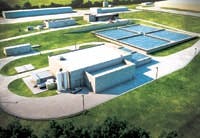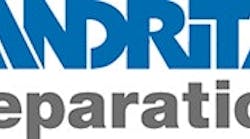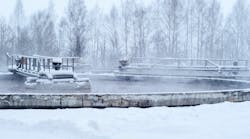The city of Cape Girardeau, located approximately 100 miles south of St. Louis with a population of about 38,000 and treating more than 7 million gal of wastewater per day (mgd), had a problem. In fact, it had several problems.
The city’s original wastewater treatment plant was constructed in 1962 and was in need of expansion to meet new discharge limits. Sinkholes in the vicinity of the planned expansion site did not allow the city to proceed as hoped. Cape Girardeau officials concluded they would need to design and construct a completely new wastewater treatment plant at a greenfield site in order to meet all challenges and new discharge limits.
Minimizing High Costs
The new site chosen for the plant was in a high-traffic area with recreational activities nearby, making odor control a priority. Faced with these new discharge limits and regulations, Cape Girardeau would be forced to further expand its current land application program. This was going to require trucking the sludge greater distances and retaining additional land, resulting in significant cost increases to the city’s current biosolids management and disposal program.
Cape Girardeau set out to create a design criteria that addressed both current and future regulations while minimizing both capital and operating costs. Studies concluded that in order to determine the best fit for a new biosolids program, it was important to adapt the proper perspective, consider efficiency, find a solution to fit local needs, calculate life-cycle analysis, and consider long-range effects and concerns.
While evaluating all options for its new biosolids management and disposal program, the city considered various Class A and B options, which addressed both volume reduction and ease of operation and were not strictly focused on the lowest capital cost. The city concluded that its disposal problems were best served by a Class A solution and thus incorporated one into its new wastewater treatment plant.
Technology Assessment
A Class A biosolids program addressed all of the primary concerns, including future regulations, beneficial use opportunities, sustainability and disposal flexibility. Through an extensive due diligence process that included technology reviews, life-cycle analysis and site visits, Cape Girardeau settled on a design based on a sequencing batch reactor (SBR) treatment system, followed by centrifuge dewatering and a belt drying system.
Andritz Separation Inc. was actively involved in providing technical information on dewatering and thermal drying processes in general, and the benefits of the centrifuge and belt drying system in particular. Technical visits to multiple installations convinced the city review group that the centrifuge technology followed by the belt dryer system was the optimum choice for the new plant. Cape Girardeau, in conjunction with consultant Jacobs Eng., developed a competitive procurement bid process, which involved detailed documents along with review and evaluation of the bids based on conformance, exceptions, O&M costs, price, product volume, product quality, process complexity and working environment. This review and evaluation process allowed the city to determine the technology that would best suit its needs.
Solid Solution
Andritz was awarded a contract to supply two D5LX dewatering centrifuges and the belt drying system BDS-15 for the new plant.
The D5LX centrifuges will receive waste activated sludge from the aerated holding tanks at approximately 0.85% to 2% total solids (TS), and operate at throughputs in the range of 180 gal per minute to produce approximately 20% TS cake solids (exact performance criteria is unpredictable as the plant has not yet been in production). The dewatered cake solids from the centrifuges will then be transferred to the belt drying system. The BDS-15 uses low-temperature air (approximately 130°C) to dry the biosolids, and is designed to evaporate up to 2,887 lb of water per hour and produce a hard pellet of approximately 92% TS, meeting the Class A requirements under the U.S. Environmental Protection Agency 40 CFR Part 503 Regulations.
The dried final product will be transferred to a storage silo where the city will have options for the final disposal method. This system will open the door to several disposal options providing the flexibility and product quality that allows Cape Girardeau to meet current and future needs. Combining the dewatering and drying process from one vendor benefits the city by allowing one competent, qualified vendor to offer a complete system guarantee.
The city’s complete new wastewater treatment system will consist of influent pump stations, fine screens, grit removal, odor control, sequencing batch reactor, centrifuge dewatering, belt drying, ultraviolet disinfection, post aeration and gravity discharge to the Mississippi River. A new administration building and laboratory will complete the facility. The plant is designed for an average flow of 11 mgd with a peak hourly capacity of up to 50 mgd. Construction of the new facility has begun and is slated to be operational in 2014.
Download: Here



